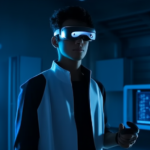Unveiling the Power of Computer Vision: Transforming Industries Today
In an era where technology continues to redefine the boundaries of human capability, computer vision stands out as one of the most transformative innovations. At its core, computer vision is a field of artificial intelligence that enables machines to interpret and understand visual information from the world—just as humans do with their eyes and brains. By leveraging advanced algorithms, deep learning models, and vast datasets, computer vision systems can analyze images, videos, and real-time data to identify patterns, detect anomalies, and make decisions. This ability to “see” and process visual input has profound implications across industries, driving innovation, enhancing efficiency, and solving some of the most pressing challenges of our time.
As businesses and societies increasingly rely on automation and data-driven insights, the importance of computer vision cannot be overstated. It is not merely about replicating human sight but augmenting it—providing tools that can operate faster, more accurately, and without fatigue. From detecting diseases in medical scans to optimizing supply chains in manufacturing, the applications of computer vision are vast and varied. In this article, we will explore how this groundbreaking technology is reshaping key sectors such as healthcare, manufacturing, retail, agriculture, and transportation, offering specific examples and insights into its impact. Finally, we will reflect on the future potential of computer vision while considering the ethical dimensions of its widespread adoption.
Revolutionizing Healthcare with Computer Vision
The healthcare industry has long been at the forefront of adopting cutting-edge technologies, and computer vision is no exception. One of the most significant applications of this technology lies in medical imaging. For instance, computer vision systems can analyze X-rays, MRIs, and CT scans with remarkable precision, often surpassing human radiologists in detecting abnormalities such as tumors, fractures, or early signs of diseases like cancer. Companies and research institutions are developing AI-powered tools that assist doctors in diagnosing conditions faster and more accurately, ultimately improving patient outcomes.
Beyond diagnostics, computer vision is also transforming surgical procedures. Advanced systems equipped with cameras and sensors provide surgeons with real-time visual feedback during operations, enabling them to navigate complex anatomical structures with greater confidence. Additionally, wearable devices and remote monitoring systems powered by computer vision are helping healthcare providers track patients’ vital signs and movements, ensuring timely interventions when necessary. These innovations not only enhance the quality of care but also reduce the burden on healthcare professionals, allowing them to focus on more critical tasks.
Streamlining Manufacturing Through Automation
In the manufacturing sector, efficiency and precision are paramount, and computer vision is playing a pivotal role in achieving both. On assembly lines, computer vision systems are used for quality control, inspecting products for defects or inconsistencies that might be missed by the human eye. For example, automotive manufacturers employ computer vision to examine car parts for scratches, dents, or misalignments, ensuring that only flawless components make it to the final product.
Moreover, computer vision facilitates predictive maintenance, a practice that involves monitoring equipment to anticipate failures before they occur. By analyzing visual data from machinery, these systems can detect signs of wear and tear, alerting operators to potential issues. This proactive approach minimizes downtime, reduces repair costs, and extends the lifespan of equipment. Beyond production floors, computer vision is also being integrated into logistics and inventory management, where it helps track materials, optimize storage, and streamline workflows. The result is a leaner, more agile manufacturing process capable of meeting the demands of modern markets.
Enhancing Retail Experiences
Retail is another industry where computer vision is making waves, redefining how businesses interact with customers and manage operations. One of the most visible applications is in cashier-less stores, where computer vision powers automated checkout systems. Shoppers simply pick up items and walk out, with cameras tracking their selections and charging them accordingly. This seamless experience not only saves time but also enhances customer satisfaction by eliminating long queues.
Computer vision is also revolutionizing inventory management in retail. Smart shelves equipped with cameras monitor stock levels in real time, alerting staff when items need restocking. This ensures that popular products are always available, reducing lost sales opportunities. Furthermore, retailers are using computer vision to analyze shopper behavior, gaining insights into which products attract the most attention and how customers navigate stores. These data-driven strategies enable businesses to optimize store layouts, personalize marketing efforts, and ultimately boost revenue.
Driving Innovation in Agriculture
Agriculture, a sector deeply rooted in tradition, is undergoing a digital transformation fueled by computer vision. Farmers are increasingly turning to this technology to address challenges such as labor shortages, climate change, and food security. Drones equipped with computer vision cameras are being used to survey crops, identifying areas affected by pests, diseases, or nutrient deficiencies. This allows farmers to take targeted actions, minimizing waste and maximizing yields.
In livestock farming, computer vision systems monitor animal health and behavior, detecting early signs of illness or distress. For example, cameras installed in barns can track cattle movements and feeding patterns, providing farmers with actionable insights to improve animal welfare and productivity. Additionally, autonomous tractors and harvesters guided by computer vision are streamlining planting and harvesting processes, reducing reliance on manual labor while increasing efficiency. As the global population continues to grow, the role of computer vision in ensuring sustainable agricultural practices will only become more critical.
Transforming Transportation and Mobility
The transportation industry is perhaps one of the most dynamic arenas for computer vision applications. Self-driving cars, arguably the most high-profile use case, rely heavily on computer vision to perceive their surroundings. Cameras mounted on vehicles capture real-time images of roads, pedestrians, traffic signals, and other obstacles, which are then processed by AI algorithms to guide safe navigation. While fully autonomous vehicles are still in development, semi-autonomous features like lane-keeping assistance and adaptive cruise control are already enhancing road safety.
Beyond personal vehicles, computer vision is also reshaping public transportation and logistics. For instance, smart traffic management systems use cameras to monitor congestion and adjust signal timings dynamically, reducing travel times and emissions. In logistics, computer vision optimizes warehouse operations by automating package sorting and tracking shipments throughout the supply chain. These advancements not only improve operational efficiency but also contribute to greener, more sustainable transportation networks.
The Future Potential and Ethical Considerations
As we look to the future, the transformative potential of computer vision is virtually limitless. Emerging applications include augmented reality experiences, enhanced security systems, and even environmental conservation efforts. However, with great power comes great responsibility. The widespread adoption of computer vision raises important ethical questions that must be addressed. Issues such as data privacy, algorithmic bias, and job displacement require careful consideration to ensure that the benefits of this technology are equitably distributed.
To harness the full potential of computer vision, stakeholders must prioritize transparency, accountability, and inclusivity in its development and deployment. Collaborative efforts between governments, businesses, and communities will be essential to establish guidelines and frameworks that protect individual rights while fostering innovation. By doing so, we can create a future where computer vision serves as a force for good, empowering industries and societies alike.
In conclusion, computer vision is not just a technological advancement—it is a catalyst for change across industries. From healthcare to agriculture, manufacturing to transportation, its impact is undeniable. As we continue to unveil the power of this remarkable technology, we must remain mindful of its implications and strive to build a world where progress aligns with ethical principles. The journey has only just begun, and the possibilities are boundless.


